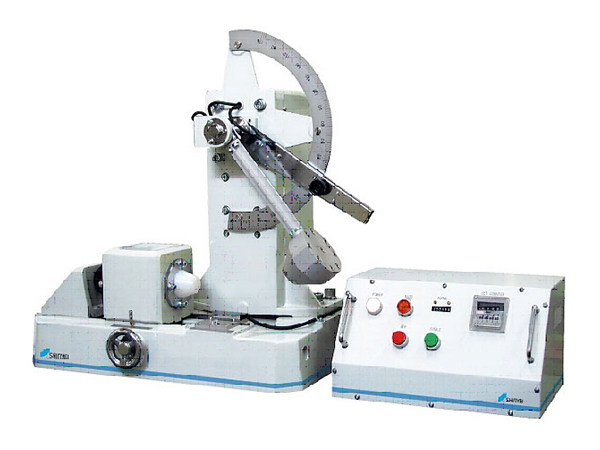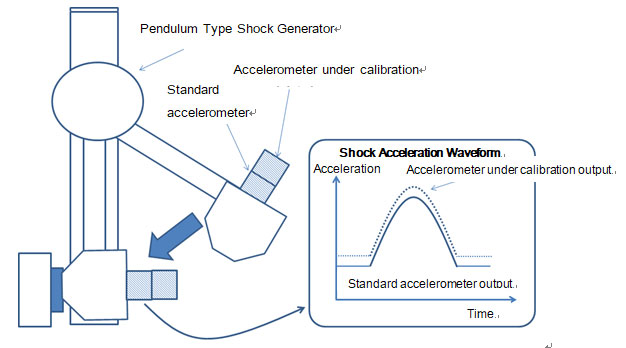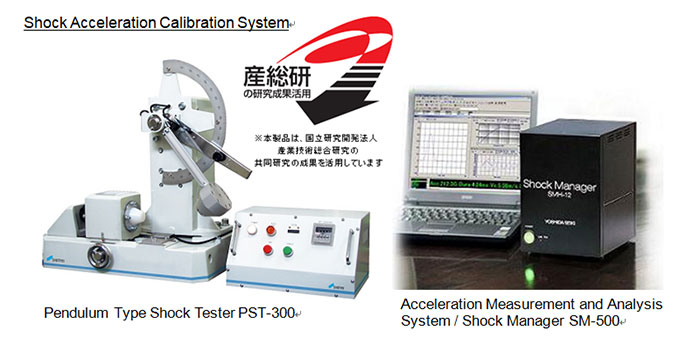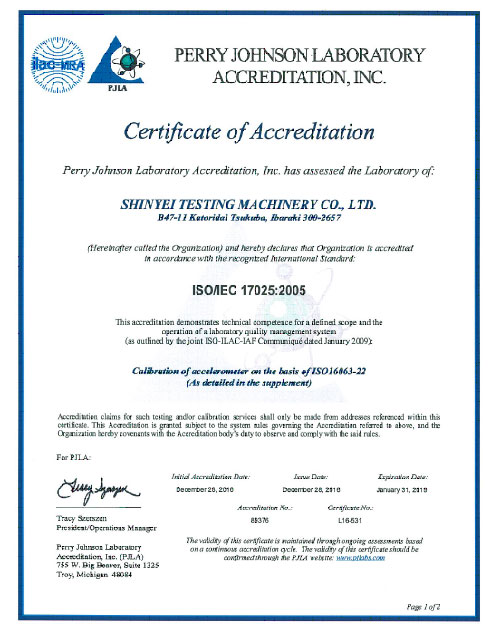Development of Shock Calibration System through joint research with AIST
SHINYEI has developed a Shock calibration system (Fig.1) based on ISO 16063-22 through joint research with the National Institute of Advanced Industrial Science and Technology (AIST). Furthermore, in shock calibration using this system, we have obtained ISO / IEC 17025 certificate (Fig.2), which guarantees reliability of calibration results according to the international laboratory accreditation standard.
In recent years “Shock Acceleration” has been receiving increased attention to evaluate index for the impact resistance of products. As an example for automotive industry, “Shock acceleration” is adopted as international standards for collision safety evaluation of the human body and shock resistance evaluation of in-vehicle components, and in Europe the measuring instruments are required to be calibrated in accordance with ISO / IEC 17025.
In addition, “Shock Acceleration” is also used for the evaluation of the shock characteristics of electronic devices such as smartphones which have a high risk factor of accidental drop, and components mounted on them, and the need for highly reliable shock measurement is increasing, although shock measurement technology and the reliability of its measurement were not good enough.
Under such circumstances, in collaboration with AIST, SHINYEI has developed a shock calibration system using a combination of a pendulum-type shock generator and an acceleration measurement device specified by various ISOs related to shock calibration and established the shock calibration technology. In addition, by acquiring ISO / IEC 17025 certificate, and now SHINYEI can issue calibration certificates with the symbol mark of ILAC / MRA (International Mutual Recognition), a highly reliable shock calibration service that is used internationally.
Contributing to the improvement of the reliability of various shock evaluation tests, we will further expand the calibration range and actively develop new shock measurement-related products and services utilizing this technology.

Figure1. Pendulum type Shock Tester
Background to the joint research
Since its predecessor, Yoshida Seiki Co., Ltd., as a manufacturer of shock test machines, we have been working on the generation and measurement of shocks for over 40 years.
In 2009, SHINYEI participated in a “Round Robin Test” of accelerometer calibration using “Shock Acceleration” with AIST as the executive secretary (* 1), and this triggered us to recognize the future importance of the standard supply of “Shock Acceleration” again. SHINYEI concluded a joint research agreement with AIST in December 2014, developed a secondary shock calibration system based on ISO 16063-22 together with Dr. Hideaki Nozato of the Institute, Research Institute of Engineering Measurement Standards, Vibration and Hardness Standards Research Group, and carried out collaborative research on the uncertainty evaluation of calibration using it.
※1 A Round Robin Test of Accelerometer in Shock Acceleration Calibration – Development of Shock Acceleration Calibration System Traceable to National Standard – Dr. Hideaki Nozato, and others. Refer to Journal of the Japan Society for Precision Engineering. 77(8),800-806,2011
About Shock Calibration System
SHINYEI uses an accelerometer that is traceable to the Japanese national standard to detect “Shock Acceleration”. We calibrate accelerometer periodically to maintain the measurement accuracy of the shock calibration system and ensure its reliability.
There are several methods of accelerometer calibration, depending on the acceleration range and purpose. In this shock calibration system, the accelerometer sensitivity of the device under test is valued by comparing the output of the accelerometer as the reference standard with the output of the accelerometer of the device.
There are several types of shock generation methods as well : a pop-up method in which a rigid body is struck from below, a drop ball method using the natural fall of a metal ball, and a pendulum method. Among them, SHINYEI adopted the pendulum method shock generator which achieved extremely high repeatability and reproducibility of shock acceleration, which is also specified in the accelerometer calibration method in "ISO 6487 (Road vehicles-Measurement techniques in impact tests-Instrumentation)" (Fig.3)
Our shock calibration system can generate peak accelerations up to tens of thousands of m / s2, and evaluate the linearity of sensitivity is higher than that of acceleration pickups used in automobile crash tests or electronic device shock tests that generate high shock acceleration.

Figure3. Pendulum Type Shock Generation and Shock Waveform
Calibration System Developed
The developed calibration system consists of a combination of a pendulum shock generator and a shock acceleration analysis system recommended by ISO 16063-22 and ISO 6487 (Fig. 4). The calibrated product is a piezoelectric accelerometer, the peak acceleration range is 300 m / s2 to 50,000 m / s2, and the calibration capability (calibration uncertainty) is 2.3% (minimum value).

Figure4. Shock Acceleration Calibration System
Future Actions
SHINYEI will expand the scope of ISO / IEC 17025 certification. (Calibration range upto 100,000 m/s2, uncertainty 1.5% or less). There are also plans to expand the range of products to be calibrated. Furthermore, we will actively expand and develop new products and services related to shock measurement utilizing the results of this joint research with the AIST.
***The National Institute of Advanced Industrial Science and Technology (AIST) : One of the largest public research organizations in Japan, focuses on the creation and practical realization of technologies useful to Japanese industry and society, and on “bridging” the gap between innovative technological seeds and commercialization.
